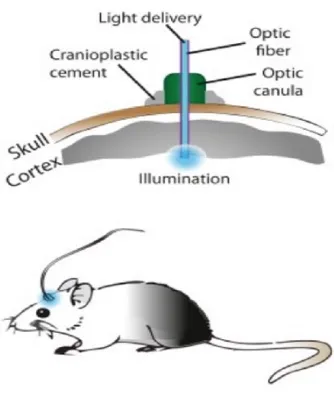Optogenetics is one of the "technologies" we're using in the Bordeaux IGEM Team's project.
In this post, I'm going to try and simplify an article I read in newscientist, adding in my own ideas along the way, to:
- present to you what Optogenetics is,
- How voles fall in love, and how to
seize control and conquer the world using our new Vole Armyunderstand the process. - What applications I see Optogenetics being used for in the future.

Source: Pama E.A. Claudia, Colzato Lorenza, Hommel Bernhard -
http://journal.frontiersin.org/article/10.3389/fpsyg.2013.00610/full
Let's first introduce what optogenetics is, so we're all on the same page.
(in case you don't know what genetics is... Go practice your Google-fu, young Padawan !)
Optogenetics, in it's simplest form, is modifying a gene to be able to selectively express it (turn it into a protein) if you expose it to a specific wavelength of light (red, blue, green, infrared...).
It's an amazingly simple concept, yet it opens the door for a lot of applications.
Everything from restoring sight in the blind, mind-controlled gene expression, to overcoming the urge to sleep at will and, the object of the rest of this post, making voles fall in love.

source: Todd Ahern, Emory University
Yep, you read that title right.
To be honest, Newscientist is a vulgarisation journal, meaning it puts a certain "spin" on their titles to make them more impactful and interesting. So it's a little more complicated than just a switch. But it's still quite fascinating !
So, let's start our story !
A team at Emory University, Atlanta, decided to study the underlying mechanism behind pair-bonding in voles, who mate for life.
They wanted to know what parts of the brain were implicated, and if they could manipulate the process. (mainly to prove that they were, indeed, the right parts of the brain they had identified, I imagine).
They first implanted electrodes into the brains of female voles to observe what happened inside their brains when they meet males, and what leads to pair-bonding.
They discovered that parts of the brain were more active during the mating and pair-bonding activities than at other times.
More specifically (and in science-speak):
rhythmic oscillations of groups of neurons in the prefrontal cortex – an area of the brain involved in decision-making and
executive functions – controlled the strength of oscillations in neurons of the neighbouring nucleus accumbens, an area
involved in pleasure, reward and addiction
Here's another little quote to bring home the point they're trying to make about the importance of this connection:
physical features of the male [...]become stamped into the reward system, meaning partners become “rewards” in themselves.
Gives a new spin to the saying "the pleasure of your company", doesn't it !
Now we get to the juicy part, where the Optogenetics come into play !
The researchers wanted to test if they could activate this circuit themselves, so they integrated modified genes, that could be activated by light, into the areas of the prefrontal cortex of the female voles, that were excited during their observations, and put the female voles in close proximity with male voles, but without allowing them to mate or interact.
During this proximity period (they could, I assume, still smell, hear and see each other), they stimulated the brains of the female voles in the test group with the same rhythmic oscillations as they had observed during pair-bonding/mating.
They then presented the female voles with 2 males. One they had interacted with during the stimulation, and a stranger.
Of the 12 voles, 10 preferred males they had been "stimulated" with.
For the control group, in which 12 female voles had an irrelevant gene stimulated (I assume to make sure the act of stimulation and the brain surgery itself wasn't a factor in the choice) during their period with a male. Only 3 choose the male they'd been exposed to before.
Interesting, isn't it.
What can we learn from this ?
Well, first of all, a warning for the ladies :
Don't let a man implant electrodes in your brain,
he might just be trying to manipulate you into becoming his lifelong mate ! ;)
But most of all we can see the potential this technology has.
Given its superb temporal (light is pretty fast at getting to its target) and spatial (we can target individual genes) resolution, it's open to a lot of big, as well as precise, possibilities.
This part is complete supposition, based on nothing but the most basic of facts (AKA., the definition of optogenetics at the beginning of this article).
But don't worry, most of my friends say my best feature is my nearly boundless imagination !
So, there are a lot of possible ways to use and misuse optogenetics.
Let me make a small list of positive, then negative ways I imagine this technology/method could be misused. Some will have a bit of argumentation, others I'll just throw out there, so you can wrap your head around them !
Positive applications of optogenetics:
Augmenting our visual spectrum. By adding more of the proteins that allow us to perceive different colors, modified to perceive things like infrared or X-rays, our brain should actually be able to just interpret the signals coherently and add it to the rest as part of the visual system. of course, that's only a theory.
Limb regeneration. As mentioned in my post introducing our IGEM project one possible application would be to regerenate limbs. Mainly by using the light to control which cell differentiates into what at the exact time and placement needed to ensure we don't grow a new arm entirely composed of skin... That... would be a bit embarrassing for the doctor to explain.
Tattoos that change based on light conditions.
Negative uses of optogenetics:
Assassination. inject someone with a poison contained within a bacteria that will only release it under very specific light conditions. Make it when all the lights are off and make it a poison that induces a heart attack, and you've got a "passed away in his sleep" death.
Memory erasing. "please look at this" ZAP. a dictatorship could potentially engineer people at birth so as to have their recent memories erased whenever submitted to a special wavelength of light. The Military police would then only need to flash any witnesses if they take out a protester and voila, no witnesses. more sinister would be having a "switch" that just destroys the brain from the inside if it's thrown.
Source for article and pictures:
https://en.wikipedia.org/wiki/Optogenetics
https://www.newscientist.com/article/2133227-brain-switch-in-voles-makes-them-fall-in-love-at-first-sight/
https://www.flickr.com/photos/30793552@N04/7523368472